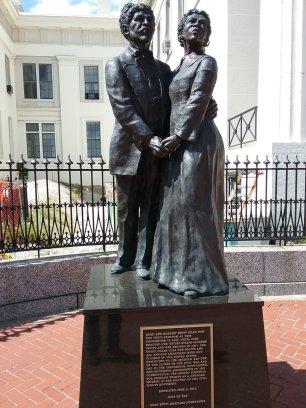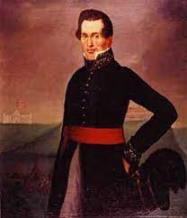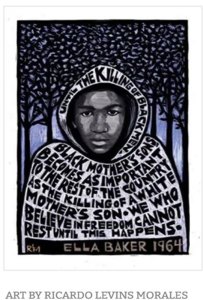Only Minneapolis can claim Dred Scott and George Floyd, two ordinary men whose names are signposts in American history.
By Susu Jeffrey Original to Rise Up Times February 25, 2022
Dred Scott: Once Free—Always Free
The man who became Dred Scott was born in 1795 (or 1799) in Southampton County, Virginia, to enslaved parents who called him Sam. Peter Blow, who owned Sam, moved his family and five slaves to Huntsville, Alabama from 1818-30 until they quit their cotton plantation and moved west to St. Louis to run a boarding house.
Although Dred Scott’s name and date of birth are not certain the fact that the Dred Scott Case is one of the most important Supreme Court cases is indisputable. How Sam became Dred apparently came from a chosen, family name, Etheldred—old English meaning noble and strong—from a Blow relative two owners back. Dred was about 5-feet, 4-inches tall, very dark complected, illiterate and reportedly charming.
During this American period of exploration and settlement of the 1803 Louisiana Purchase, the young government pushed to expel Indian people and French and English business out of the great land acquisition from New Orleans to Montana. It was also a time of intensification of the slavery question: Were blacks “people” in a nation whose foundational document stated “all men are created equal.”
Dred’s first wife was sold “downriver” when he was 19, a practice to make money to pay debts or punish disobedient slaves who were sold into the deep south to mosquito infested Mississippi or Louisiana plantations as field workers. In St. Louis, runaway slaves often hid in the Mississippi River swampland east of the city. Gangs of young thugs would hunt them down and return them to their owners for reward money.
After Peter Blow’s death, 1832, Dred was sold to US army surgeon Dr. John Emerson, an Irish immigrant, a congenial fellow, medically trained in Philadelphia, ambitious for a permanent army appointment. Dr. Emerson acquired Dred for a valet and personal assistant. Valets were expected to prepare meals, clean officers’ quarters, uniforms, boots and groom their horses. Additionally Dred, as a doctor’s assistant, was instructed in inoculating soldiers against cholera and other medical procedures.
The army supported slavery with a monthly stipend for a servant. Dr. Emerson also collected money from hiring Dred out to other officers. Meanwhile the doctor and others staked out land claims across the Mississippi in Iowa, anticipating the opening of western lands.
Dred accompanied Dr. Emerson as he was transferred to each new army post and in 1835 journeyed to Fort Armstrong in the free (non-slave) state of Illinois. The River fort was situated on what is now called Rock Island, a garden of strawberries, blackberries, gooseberries, plums, apples, nuts, and teeming with fish in the river rapids and sacred to the Sauk Indians. An island guardian spirit with great white swan-like wings lived in a cave under the island.
In 1832 a cholera epidemic, brought to the area by 220 survivors of a thousand strong US army force sent to subdue Sauk people in the Black Hawk War, decimated both Indians and soldiers. Nevertheless, the Sauk and Fox were forced to cede their lands east of the Mississippi in 1834. Afterwards a small military contingent was kept on the island to hold the Native people back and to discourage French and English Canadians from trading with them.
By 1836 Dr. Emerson was transferred, again northward to Fort Snelling in the free Wisconsin Territory at the confluence of the Mississippi and Minnesota rivers, called by native Dakota people, B’dota, the meeting of waters. Like the Rock Island spirit of the Sauk people, Dakota people had a powerful deity, Un K’Te He, who dwelt amid the underground water passages and the great hill where (platform) sky burials were set.
Image: Minneapolis Institute of Arts
Seth Eastman’s watercolor, Indian Burial Place Near Fort Snelling (1846-48), depicts scaffolds atop a great rise, open to the sky and to birds that would clean the corpses allowing bones to be collected perhaps a year later and interred.
Dr. Emerson’s frequent transfers resulted from a combination of yearnings and opportunity in addition to his physical complaints, which included rheumatism and syphilis. He didn’t like the hot weather in Louisiana or the cold weather in Minnesota, additionally he was searching for a suitable bride.
From 1836 to 1840 Dred Scott lived at Fort Snelling where slavery was practiced, even though prohibited. He and the doctor traveled south to Fort Jesup, along the Red River of the South in Alexandria, Louisiana. This was disputed border area of the Louisiana Purchase between Spanish-Mexico and the US, troubled by slave insurrections and a flood of settlers.

Statue of Dred and Harriet Scott in front of the Old Court House in St. Louis, MO. This is the court house where the Dred Scott lawsuit was filed. Photo: Smithsonian
Back at Fort Snelling Dred (now about 40 years old) met and married Harriet Robinson (a 17-year-old servant girl). Their 1837 wedding was performed by Indian agent Lawrence Taliaferro (pronounced Tolliver), her master who “gave” Harriet to Dred. Taliaferro was quitting the Indian agency business, blaming the American Fur Company for the exploitation of his Native “children” and seeing that his dependents Harriet and Mary, a Metis daughter, would be well-placed.
The Taliaferros were Presbyterians who came west from Bedford, Pennsylvania, where Harriet was a member of the African church. On the frontier where survival was daily struggle religion was left to Indian missionaries.
Harriet moved from the Indian agency outside the enclosed fort into Dred’s basement hospital quarters. It was illegal for slaves to marry. Native American marriages were also unrecognized.
Dred and Harriet lived in relative privacy in their basement quarters, hired out to various officers, the money for their work paid to Emerson, who was dispatched to Louisiana. Taliaferro accompanied a Dakota delegation to Washington DC for treaty (land) negotiations. With Taliaferro out of the area the Dakota and Anishinabe conducted circular murderous raids and his years of peacemaking as Indian agent fell apart. Harriet became pregnant about New Years of 1838.
Dr. Emerson married Irene Sanford in February 1838 and sent for Dred and Harriet to serve the couple in Louisiana. The Sanford family on principle did not emancipate their slaves. The Scotts arrived in St. Louis in June; however in late summer Dr. Emerson was transferred back to Fort Snelling. Dred and Harriet survived independently in St. Louis until they joined the Emersons in late September aboard a small sternwheeler traveling upriver.
The Scott’s first child, Eliza, was born on the boat in the middle of the Mississippi in the free Northwest Territory where slavery was banned.
Military officers and traders engaged in land claims as frontier hardship perks. Indian agents and sutlers (civilian storekeepers), except for Taliaferro, were especially corrupt at lying with their pencils, stretching Indian credit figures so that when annuities arrived the traders could prove, on paper, the tremendous debts Indian people had amassed.
The Long, Long Arc of Justice
Land speculation exploited Indian cultures and encouraged the greed game, turning settlers and the military into suspicious malcontents. Dr. Emerson had more than 600 acres of claims in Iowa from his Fort Armstrong days.
Around Fort Snelling free roaming cattle slaughtered by Indians on their own land infuriated settlers, who were about to lose their homesteads after a decade—plus because the fort wanted to expand military reserve land.
On May 6, 1840 soldiers destroyed the Camp Coldwater civilian settlement of nearly 100 people by ripping off roofs and setting fire to all cabins. Blue and white fragments of squatter-leader Abraham and Mary Ann Perry and their six children’s broken Spode China popped out of the ground beside Coldwater Creek at spring thaw, even in recent decades.
The land-takings excuse was to preserve firewood and the increasingly sparce game, and especially to curtail the whiskey trade that settlers sold to Natives and soldiers. Drunkenness and desertion were rampart among common soldiers and was punished by flogging. It was a brutal time with warring Indians and dispossessed settlers, which resulted in a breakdown in military discipline and in force as a substitute for justice.
By 1839 Dred and Harriet were squirreling away tiny sums and seeking extra jobs with payment that did not go directly to the ailing Dr. Emerson, a great privilege in the tightly controlled military economy.
Each bandage had to be accounted for, but Dr. Emerson traded his excess hospital food allotments for other supplies. Unfortunately, he was drummed out of the military in 1842 for having donated food to hungry Dakota people.
 Lawrence Taliaferro
Lawrence Taliaferro
Source: National Archive
Taliaferro resigned as Indian agent in July after more than a quarter century of service, blaming the American Fur Company’s money and influence from the Mississippi to Washington. He noted more deaths than births among the Indians. With Taliaferro’s departure and the increasing Dakota-Anishinabe battles the Indian farming experiment around Bde Maka Ska (‘white sand lake’ Calhoun) dissolved.
For the 1839-40 winter Dr. Emerson requisitioned two free-standing cast-iron stoves, one for himself and his wife, the other for Dred, Harriet and the baby in their basement room. This thoughtful act was an astonishingly thoughtful action for a master to his slaves. In May 1840 Dr. Emerson left Fort Snelling for the Seminole War in Florida, dropping off his wife and Dred and Harriet in St. Louis.
From Free Territory to Slave State
Little is known of Dred Scott’s next four years in St. Louis which was a major slave market in a crowded frontier river city of 17,000. Dred and Harriet probably went with Mistress Irene Sanford Emerson to her father’s farm outside the city, lived in slave quarters sleeping on a rag mattress on a dirt floor, and labored as house servant and laundress. There was no privacy and whipping slaves was a common practice for even slight infractions.
The Scott slave family was waiting for Dr. Emerson to return from the war, wondering where his next assignment would take them. As the war wound down the army began discharging excess officers and the complaining Emerson was let go in June 1842. The doctor returned to St. Louis, wrote pathetic letters begging for reinstatement, and probably rented out his slaves to save money.
By summer Mistress Irene, still in St. Louis, was pregnant, while Dr. Emerson was trying to establish himself in Davenport, Iowa near his old land claims. Meanwhile a younger Sanford sister, Mary, and her officer husband Capt. Bainbridge, were assigned to Jefferson Barracks, a major army post just south of St. Louis.
The Bainbridges rented the Scotts for two years, Dred as cook, buggy driver and valet, Harriet assisting Mistress Mary with housework and laundry. The captain and his wife, childless, were the center of an extremely lively military social scene
Dr. John Emerson died in December 1843 in Iowa, a month after his baby daughter’s birth. Widow Irene and infant returned to her father, Col. Sanford’s St. Louis farm. Harriet was pregnant again and had lost at least one son since Eliza’s birth. Baby Lizzie was born, and by April 1844 Dred with Capt. Bainbridge were headed for the next westward expansionist war to incorporate northern Mexico into the US.
For the next two years Harriet worked “out” with her wages going to Widow Irene’s father, which saved the money of feeding and clothing Harriet and the two little girls. If slaves didn’t board with their masters St. Louis’ free and enslaved blacks lived in put together shacks lining alleys behind white residences.
Monday was laundry day. Mississippi River water was drawn and left to let the silt settle otherwise the laundry would be stained the brown of river water. “Big Muddy,” one of the Mississippi’s nicknames, carried so much eroded soil that laundresses had to wait for particles to sink to the bottom and use only the top water skimmed into another container. Meanwhile a fire was built under the boiling pot with wood that had to be purchased. After the heavy work of washing in wooden tubs on a wash board and rinsing, came ironing, starching, and finally delivering the clean linens and clothing on Saturday and picking up the next week’s laundry.
Each sheet, pillow case, towel, table cloth, shirt and other clothing item had to be accounted for and guarded against theft during the week by laundresses. Harriet probably made her own soap with lye from hardwood ashes and fat drippings. Sunday was the day for church and the network place for news, connections for self-help, survival, literacy, complicated slave laws, singing and spiritual sustenance.
While Harriet worked to support herself and her two daughters, Dred was with the army camped out for a year and a half in the Louisiana backwoods and then moved into Texas and Mexico for the war. With fighting imminent, the captain sent Dred back to St. Louis. He arrived in March of 1846 with money he’d saved to buy his freedom.
Dred had a white man pledge his bond, he told Widow Irene. She refused to allow him to purchase his emancipation. Dred was over 50, spare and hardly worth his keep but Harriet and the two young girls were of significant value. Old Col. Sanford, who controlled the family finances, was opposed to manumission. Dred and Harriet faced a future of being rented out or even sold. Eliza, then eight, would be very salable.
Within a month Dred and Harriet filed for their freedom as a married couple, which prevented any Scott sale. Attorney Francis Murdoch represented the Scotts on the basis of their residence in free territory. Once free—always free was a common standard that Missouri courts usually observed when slaves lived in “free” states or territories as Dred did in Illinois and both Scotts did at Fort Snelling in the free Wisconsin Territory.
Emerson filed for dismissal of the freedom suit. Meanwhile Dred and Harriet needed a place to live and independent work to pay for food, shelter, clothing and laundry supplies. For the case they had to find witnesses to their living in non-slave areas and define specifically who was enslaving them. It was seventeen years before the Civil War but being “soft” on slavery made one a social and political pariah.
By spring of 1844 attorney Murdoch had left town, leaving the Scotts with a case but no lawyer. The next lawyer was Charles Drake, then his junior partner a Mr. Lakeland, then Samuel Bay, just before trial after 18-months of waiting, in June 1847. Bay couldn’t specifically link Widow Emerson to the grocer where the Scotts had been working. Actually the grocer paid old Col. Sanford for the Scotts labor. The case was lost. The judge granted the Scotts a new trial.
Bay bowed out. Alexander Field was the next council followed by his junior David Hall. In February 1848 old Col. Sanford died. Widow Emerson hired Dred out to lawyer Hall as office janitor for two years until he too died. The Scott family apparently boarded at the jail whenever they were not hired out. A cholera epidemic hit St. Louis, court business was suspended along with 300 other cases.
A fire swept the moored boats along the Mississippi and warehouses in May 1849. Having worked for Dr. Emerson, Dred and Harriet were employed during the continuing epidemic by other doctors. City business was crippled by disease.
Another Sanford sister was widowed after the Mexican War and became dependent on their very wealthy brother John F.A. Sanford, the sole recipient of the father’s farm and goods. The young widows and their children along with the colonel’s widow moved to Springfield, Massachusetts to live near a well-to-do sister in the increasingly anti-slavery north. If Mistress Irene was cash-strapped she could have taken Dred up on his offer to purchase his own freedom.
Finally in December 1849 the Scott case was listed to be heard. On January 12, 1850, four years after the case was filed, the Scotts won their freedom from widow Irene under whose control they worked. Hallelujah!
SOURCES
The main source for Dred Scott’s life was Mrs. Dred Scott: A Life on Slavery’s Frontier, Lea VanderVelde, Oxford University Press, 2009. Additionally every person, location, war and social reference was verified.
Subscribe to RiseUpTimes.org Support independent media. Please donate today and share articles widely.
The contents of Rise Up Times may or may not reflect the views of the editor.


